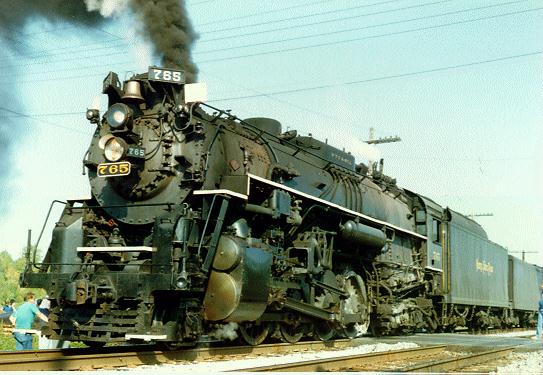

New York, Chicago & St. Louis Berkshire Type Locomotives (Nickel Plate Road)
There is an alternate story of how the Nickel Plate Road got that name. When William Vanderbilt sought to purchase the NYC&StL, to remove it as a competitor with his New York Central, the price, which he was quoted was, in his view, so exorbitant that he exclaimed, "My God! Your railroad must be nickel-plated!"
In 1927, the Nickel Plate Road was part of a group of railroads controlled by two brothers, Oris and Mantis Van Sweringen. Along with the Nickel Plate Road they controlled the C & O, the Pere Marquette and the Hocking Valley Railroad. The Van Sweringens established the "Advisory Mechanical Committee", which represented the best design talents from the four railroads.
This committee, after exhaustive studies and tests, used the most favorable ratios, proportions and characteristics of the Erie Railroad's 2-8-4 of 1927, and enlarged it into the famous C & O Class T-1, 2-10-4, which were built by Lima in 1930. In 1934, the process was applied in reverse from the 2-10-4 and the equally famous Nickel Plate Road "Berkshire" Class S, 2-8-4 resulted.
In 1934, the NKP took delivery of fifteen of the new "Berkshires" from the American Locomotive Company. These new locomotives were perfectly suited for the NKP and with them they set record after record. In all the NKP bought eighty "Berkshires", fifteen from ALCO and the balance from Lima Locomotive Works and numbered them 700 through 779.
These locomotives had 69" diameter drivers, 25" x 34" cylinders, a 245 psi boiler pressure, they exerted 64,135 pounds of tractive effort and each weighed between 261,100 to 266,030 pounds.
There are six surviving NKP 2-8-4 "Berkshire" type locomotives. They are: number 755 at the Conneaut Railroad Historical Museum in Conneaut, OH, number 757 at the Railroad Museum of Pennsylvania in Strasburg, PA, number 759 at Steamtown National Historic Site in Scranton, PA, number 763 at the Virginia Museum of Transportation in Roanoke, VA, number 765 at the Fort Wayne Railroad Historical Society on Edgerton Rd in New Haven, IN and number 779 at Lincoln Park in Lima, OH
| NKP 2-8-4 Roster | |||||
|---|---|---|---|---|---|
| Class | Qty. | Road Numbers | Year Built | Builder | Notes |
| S | 15 | 700-714 | 1934 | ALCO | 1 |
| S-1 | 15 | 715-729 | 1942 | Lima | 2 |
| S-1 | 10 | 730-739 | 1943 | Lima | 3 |
| S-2 | 30 | 740-769 | 1944 | Lima | 4 |
| S-3 | 10 | 770-779 | 1949 | Lima | 5 |
| Specifications | ||||
|---|---|---|---|---|
| Class | S | S-1 | S-2 | S-3 |
| Wheel Arrangement: | 2-8-4 | 2-8-4 | 2-8-4 | 2-8-4 |
| Length: | 101'-0" | 101"-0" | 101'-0" | 101"-0" |
| Drivers: | 69" dia. | 69" dia. | 69" dia. | 69" dia. |
| Weight on Drivers: | 261,100 lbs. | 261,800 lbs. | 264,300 lbs. | 266,030 lbs. |
| Total Locomotive Weight: | 428,900 lbs. | 429,500 lbs. | 440,800 lbs. | 444,290 lbs. |
| Locomotive & Tender Weight: | 790,600 lbs. | 791,200 lbs. | 802,500 lbs. | 805,990 lbs. |
| Grate Area: | 69" dia. | 69" dia. | 69" dia. | 69" dia. |
| Cylinders (dia. x stroke): | (2) 25" x 34" | (2) 25" x 34" | (2) 25" x 34" | (2) 25" x 34" |
| Boiler Pressure: | 245 psi | 245 psi | 245 psi | 245 psi |
| Tractive Effort: | 64,135 lbs. | 64,135 lbs. | 64,135 lbs. | 64,135 lbs. |
| Tender Capacity: | ||||
| Water: | 22,000 gals. | 22,000 gals. | 22,000 gals. | 22,000 gals. |
| Coal: | 22 tons | 22 tons | 22 tons | 22 tons |
